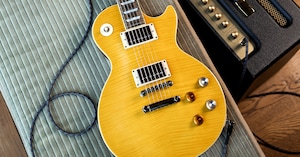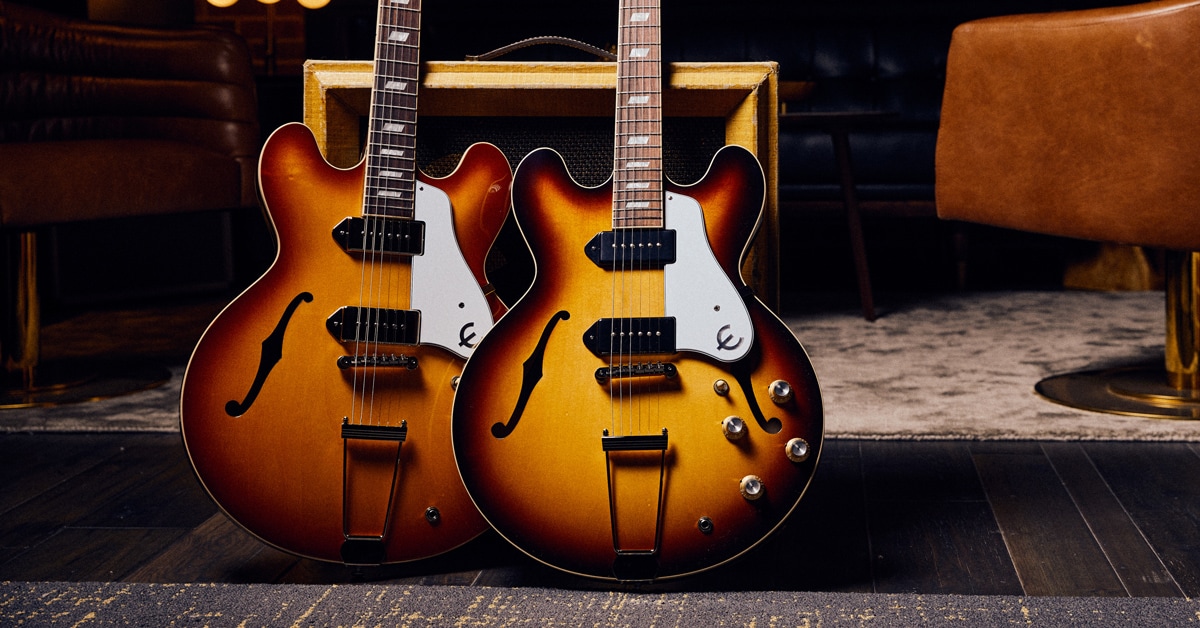You might say John, Paul and George put it on the map. In the ’60s, all three Beatles guitarists rocked an Epiphone Casino, the slimline hollowbody built in Gibson's Kalamazoo factory. Keith Richards had one, too. Paired with a VOX AC30, the Casino became the sound of the British Invasion. Like the Gibson ES-330 on which it was based, the Casino had no centerblock to reduce feedback, but let's face it: Sometimes, feedback is the answer.
For decades, Epiphone Casino guitars have been made overseas, but in 2020, the company announced that a U.S.-made Casino would return. We spoke with Gibson's Director of Brand Experience, Mark Agnesi, and Master Luthier Jim DeCola, to geek out on guitar specs and learn what other American Epiphones might be up their sleeves.
Why did you decide to go with the Casino for your first Epiphone USA electric guitar?
Agnesi: When you think of the Epiphone guitars and some of those cool, original Epiphone models, almost all of them are based on some Gibson model. In the Casino's case, it was the only Epiphone model that actually eclipsed the Gibson version. The ES-330 Gibson and the Casino. More people are probably familiar with the Casino than they are with an ES-330. It kind of made the most sense because it's really the icon of the Epiphone electric guitars.
When was the Casino last made in the U.S.?
DeCola: 1970 was the last U.S. production on that.
Agnesi: Which we've done, I think, one limited run. But this is the first time in 50 years?
DeCola: And added to the core at the USA plant.
You've done some limited Gibson ES-330 runs, right?
Agnesi: Yeah, there's another one: The Limited-Edition Slim Harpo ES-330.
What was the general approach to starting the project?
DeCola: When we started talking about developing it and making some of the early prototypes, initially, we went after the second variation with the long hourglass Epiphone headstock. I felt, since we're just starting out, we should go with the more historic, original headstock, which is a little more Gibson-esque, and that's why they changed it. So, we decided to shift gears and go to that. Starting from the beginning all over again, we wanted to take it from that.
So, it'll appeal to Paul McCartney fans.
DeCola: Yeah. That's exactly right.
Agnesi: And Keith [Richards] fans.
DeCola: Paul's my big hero, which was kind of my reason for going in that direction.
Agnesi: Keith is my big hero, so …
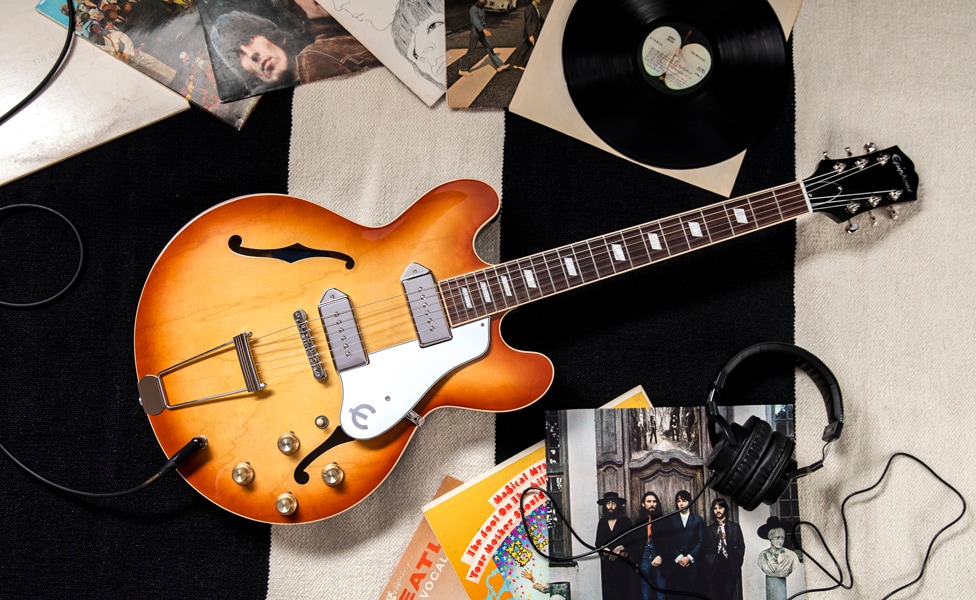
Pictured: Epiphone USA Casino in Royal Tan
Are these going to be made like they were historically?
Agnesi: Absolutely. Yeah. Made by the same people, in the same part of the factory as the ES-330s, 335s, 345s. Everything else ES.
How does this line compare to current Casino offerings?
DeCola: The current offering of Casinos, and other Epiphone models, are very, very nice guitars. However, there are significant differences in terms of the finish, for instance. That's probably the most notable aspect that comes to mind. The import versions have polyester finishes, where the U.S. will have true nitrocellulose lacquer, like everything else that we do in the U.S. So, that's very significant. And on a guitar like the Casino, that does have a substantial effect on the sound because it's so much more resonant, being that it's fully hollow. So, that, to me, is probably the most significant difference right there.
Agnesi: And pickups as well, utilizing USA-made P-90s instead of the import P-90s. So, I mean, it's the same sound spec you’ll find with any other Gibson guitar.
Does this model have a 14- or 17-degree headstock angle?
DeCola: The headstock angle changed during the last few years of production back in the day. In the late '60s, Gibson started going towards a 14-degree headstock. And the Epiphone production just mirrored that. So, now that we're building it again in the U.S. factory, we've resorted back to the 17, more historic headstock angle. So, we opted to do the same for the Casino. It just made sense.
What does that mean for playability?
DeCola: With the increased headstock pitch, you have more tension across the nut, and it just imparts a specific character to the sound. It gives a little more sustain. We've learned through our Gibson models over the years that our fans prefer that 17 over the 14. So, we went through that re-learning curve to get back to our historic roots. It just made sense to do the same thing with the Casino.
Historically speaking, what do you think drew people to the Casino instead of other Epiphone or Gibson models?
DeCola: Back in the day, when I grew up in the '70s and '80s, if you looked at the ES-330 compared to the ES-335, at that time, it wasn't considered as cool. Everyone wanted that 335. But back then, people were cranking up a lot louder, and that's kind of where their focus was. Then, as things evolved, people rediscovered the 330 and the Casino, and now they're kind of like the “cool thing” because they're fully hollow. That fully hollow quality imparts that resonance, and with the proliferation of home recording, many newer players have adopted it. And then the players who were big Beatles fans or Keith fans, or people like that, trying to research and find out how they got those iconic sounds, discovered that the Casino was a big part of that.
Agnesi: I mean that guitar to me is the sound of '60s rock and roll. It's like the quintessential rock-and-roll rhythm guitar. If you think of your favorite records, at least one of the players in the band was playing a Casino, whether the Stones, the Beatles or the Kinks. All of those great '60s rock—
DeCola: By Sgt. Pepper’s, all three Beatles were playing Casinos on that.
Agnesi: Ringo is the only guy that didn’t have a Casino in that band. [laughter]
What's your ideal rig to plug a Casino into?
Agnesi: For me, I like it through a small, low-wattage tube amp, cranked. I want that “All Day and All of the Night” Kinks sound. That “19th Nervous Breakdown” [Rolling Stones] sound. I don't like them clean, although they do great jazzy clean tones and stuff, too. For me, it's a 20-watt-or-less tube amp, turned up loud. That's, for me, the sound of a Casino.
DeCola: And for me, similar. Just a small, low-wattage tube amp, cranked, with just a little grit to it. Not super-saturated, obviously, but just that '60s kind of grit. And, for me, the first thing that pops into mind is the opening chords of Sgt. Pepper’s, which McCartney did, and it just has that growl. And it just sounds nasty.
What are the key differences between the Casino and the ES-335 models?
DeCola: We touched off on the Casino's fully hollowbody versus the center core, the maple center core, of the 335 style. Also, another noticeable difference is on the Casino. The neck is set deeper into the body. So, you have a 16th-fret neck joint at the body, whereas the 335 will be a 19th-fret neck joint. So, if you're reaching for an open E chord, it'll be less of a reach on a Casino than it would be on a 335. However, they're the same scale length. It's just deeper set into the body. And that—I think, I don't know—but I kind of suspect that may have played into why The Beatles adopted them too. If you look at some of their previous guitars, it would have a similar ergonomic approach.
Agnesi: And then you have P-90s instead of humbucking pickups. And then all of the Casino models are all going to be a trapeze tailpiece because there is no center block for studs for a stop tailpiece to go in. You're always going to see either some kind of trapeze, or maybe somebody added a Bigsby on one.
DeCola: And in the case of the trapeze or the Bigsby, on a fully hollow guitar like a 330 or a Casino, that style of guitar, fully hollow, when you have the strings anchored at the end of the body and then radiating from the bridge, now, you have those two points that the sound is radiating from. Now, you're exciting the strings at the end of the body, radiating through the rims, top and back and the bridge. Alternatively, with the stoptail on a 335 style, it's right there in the center of the guitar, kind of radiating from that bridge and block area. So, that really kind of plays into that sound and makes it a bit more dynamic, in my opinion.
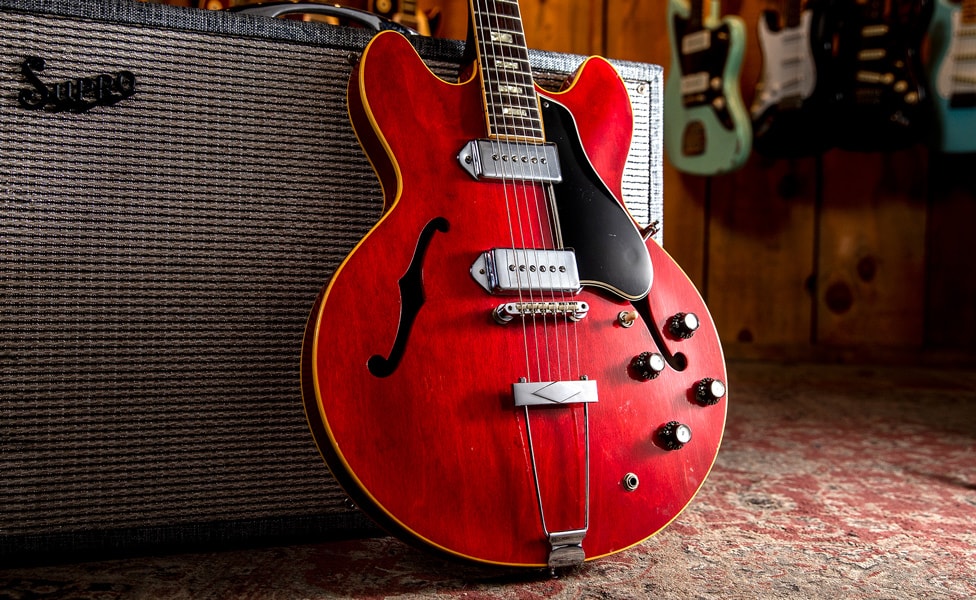
Pictured: 1967 Gibson ES-330 at Guitar Center Hollywood
Does that 16th-fret neck joint impact playability, as compared a 19th-fret neck joint?
DeCola: Yeah. You're going to have a little bit more of that sustain. It's similar to a longer neck joint, but most significantly, I think it's more of that ergonomic approach. There are so many other variables, not only with that inset neck, but the fully chambered trapeze tailpiece as well. All of that adds to that character that the Casino has.
Now, one thing, too, to note with the deeper inset neck, you don't have access to that highest fret. But for a lot of those players, especially back in the '60s with The Beatles and Keith Richards and a lot of those guys, The Kinks, they weren’t playing up at the 22nd fret anyway. And so, for them, it just worked out. That played a big part, and that was no boundary in what they were trying to do.
Do you anticipate that could maybe be a Custom Shop purchase?
Agnesi: I would love that.
DeCola: Yeah. There are those possibilities. Right now, it's early on. We talked about adding a few other models. Right now, they're not currently in development like that, but in the concept phase. But, yeah, it's wide open. And we'd love to see that.
Did you make any unique discoveries in making this?
DeCola: Not a discovery except for the basic—the headstock differences. Some of them have that rubber ring to eliminate some of that switch noise, as Lennon's had actually. Little things like that where we had to evaluate all those differences. In the end, we opted for the first issue [model] and went there.
Agnesi: More playing with the aesthetics, too, with the two different finishes and two different hardware packages on it. Trying to pick the most sought-after looks—royal tan with the nickel covers, like you would see on a '64 era, and the sunburst with the black covers, like you'd see more on '61, '62. We're trying to give everybody the two favorite looks, or most iconic looks, of the instrument. We're kind of hyper-focused on getting those kinds of details right.
How do you approach this instrument? Are you making the Casino as it sounds in a room, or are you making the Casino that people have heard on those famous recordings?
DeCola: One difference is the pickups. Right now, we're using our classic P-90 pickups with Alnico V. Initially, we considered using Alnico III magnets like we're doing on the [Gibson] Slim Harpo. His being an older model, we thought, "Well, that might sound sweeter and kind of lend itself to the Casino, but then again, let's consider all the music that we've heard growing up." At that point, when The Beatles had them, they would've had Alnico V magnets. It has that girth and that brightness and the heaviness. It still cleans up very sweetly. We're using vintage taper 500K pots, so when you roll it back, you can still get a real sweet sound out of it. We opted to go with the Alnico V because it just gives you the growl when you need it.
Do you anticipate other models getting USA runs?
Agnesi: Definitely. We’ll definitely see more Epiphones coming out of the USA factory, and we’re very, very excited about that. Again, it's going to be kind of a slow burn here bringing Epiphone back, but we're all such fans of the brand. I mean the stuff that we make overseas is incredible value and quality, but seeing Epiphone brought back to the U.S., I think that's something that we all hold pretty close to our hearts. So, I don't think this will be the only Epiphone USA model you're going to be seeing from us.
DeCola: For sure. This Casino is just the beginning. We've been talking about other models that we can't disclose just yet, but this is just the beginning.
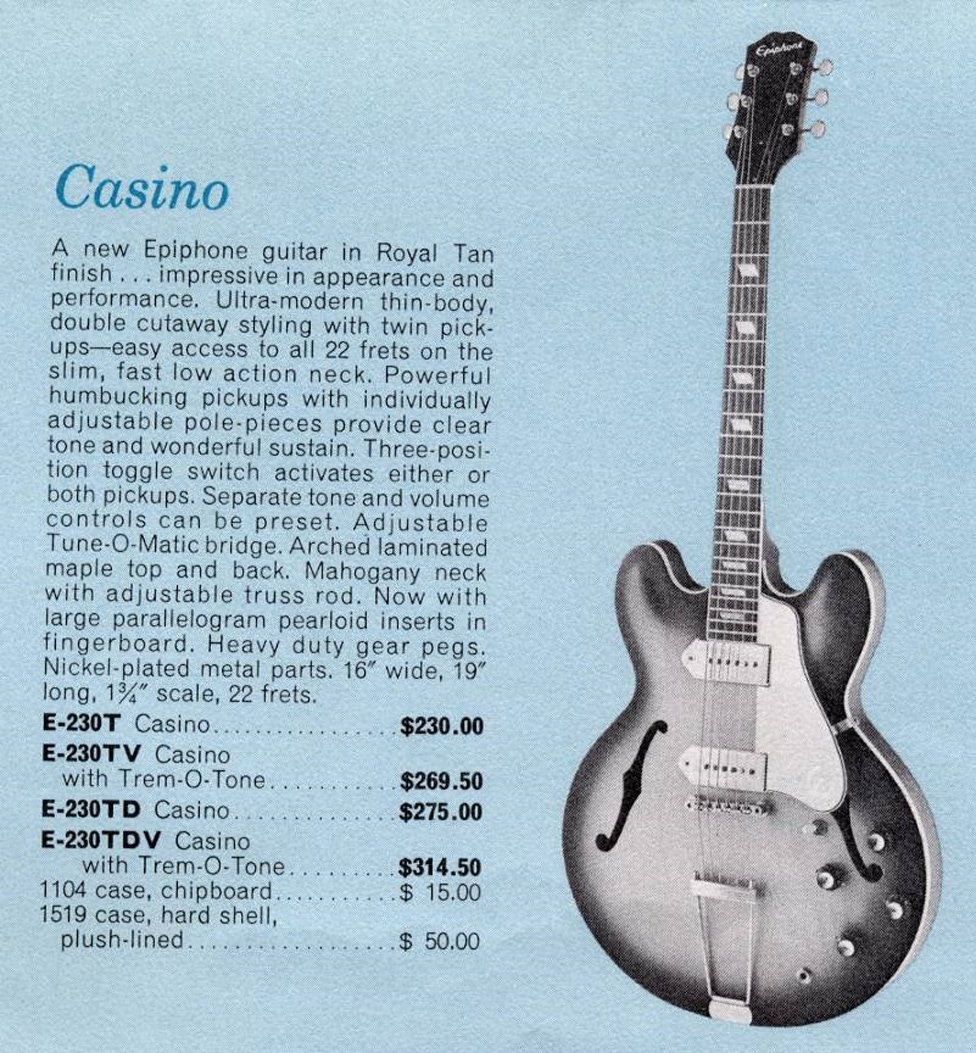
Pictured: Epiphone's 1962 Product Catalog
What's your hope with how this repositions the Epiphone brand?
Agnesi: For me, I think it comes more from a storytelling thing because there's a lot of younger players out there that still don't know that Epiphone was an American company. There's a lot of younger players that don't know Epiphone is older than Gibson. They just always have known Epiphone as this cheaper import brand. I think bringing it back to the U.S. allows us to kind of tell that story again, of why and how influential these guitars were on the music that we all grew up listening to, and all still love to this day. I think it's going to help tell the brand story bringing them back to the U.S.
DeCola: When I was growing up, I had, and still have, Olympic Specials, and I had various other Epiphone guitars and amps. I grew up in the '70s and '80s, so I was already hip to that history. But to Mark's point, there's a lot of players who don't understand that at one time, Epiphone was Gibson's biggest competition. They bought the company when they had the opportunity because they saw the potential there. At that time, Gibson may have a dealer in a given town, and then maybe a new dealer would open up. And they couldn’t have two dealers that were selling Gibson in a particular geographical area. So, they'd open one up with Epiphone. That way, they could both sell guitars. They're both coming out of the same plant, very similar models, but they wouldn’t be in direct competition. That's a big part of that story. Simultaneously, many artists were embracing the Epiphone models, and we want to honor that history and heritage.
What do you hope someone playing this guitar for the first time takes away from it?
Agnesi: For me, it's to feel the power that this guitar has. If you've never played one, that first experience of plugging one in and just hitting a chord hard through the right amp, you will immediately hear all of those records that you grew up listening to. It's one of those experiences. Once you have it in your hands and you hear it, you go, “Oh, yeah. That's that.” I want people to feel that when they pick it up. The history that's there, and the tones that that guitar helped create.
DeCola: You can play a lot of the classic songs like Mark's talking about, but until you play it on the real deal, you're only so close. It's kind of like how you can learn a bunch of Stones songs in regular tuning, but when you finally tune to open G for a lot of those classic songs, you go, “Oh, that's it.” Same thing with the Casino. Once you plug it in, it's like, “That's the sound.”
And that's very important, too, with recording. I think that's why many of these artists we’re talking about used them so prolifically back then. In a recording context, as rock and roll was evolving and feedback was coming into play with higher gain levels and all that, these artists discovered that, in the studio, they could get a lot more out of that guitar having that full chambering working for them. And at the same time, they weren’t worried about large stadium volumes. That's probably why the 335 was more preferred live with higher levels. But in the studio, something like the Casino would excel.
Agnesi: To be perfectly honest, most of the time when I pick up my Casino, I'm sitting on the couch. It is my absolute favorite "couch guitar" because it's so much louder than any other electric guitars I have. It's got all that resonance, but it's still thin, and it plays like an electric guitar. So, it's my “hanging out, watching football on Sunday” guitar. It's the perfect “couch guitar.”
DeCola: I'll do the same thing, too. You don't even miss the amp because in that kind of lounging kind of context, because it's hollow, even if you're noodling and you want that sustain, it's there. So yeah, that's another excellent reason.
Agnesi: They're just fun all around.


